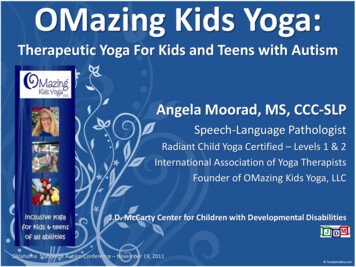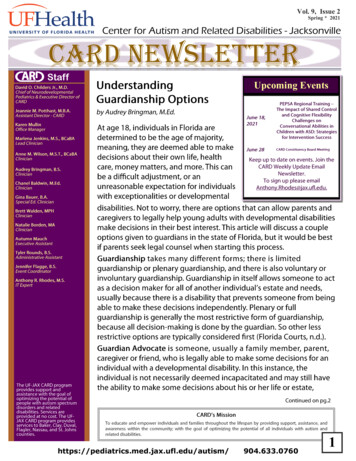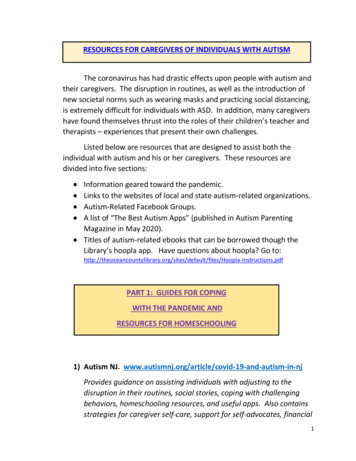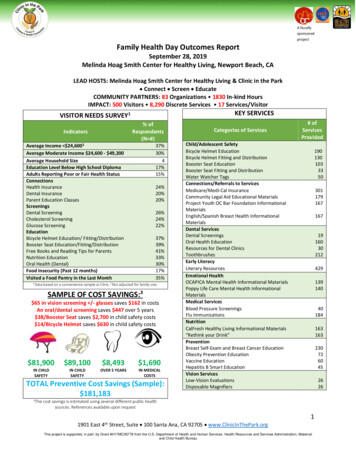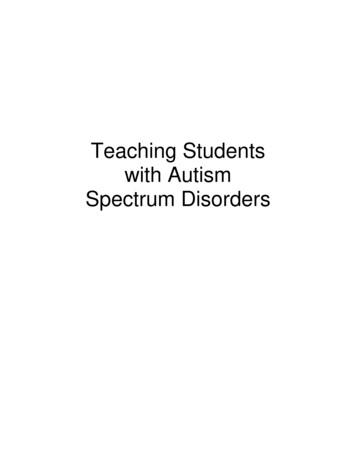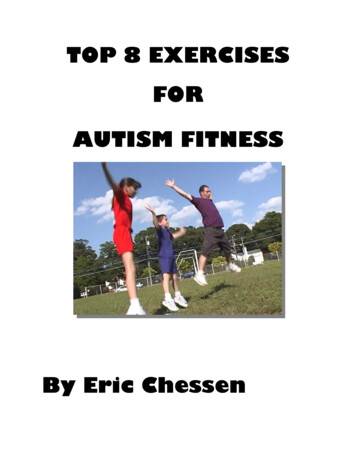
Transcription
TOP 8 EXERCISESFORAUTISM FITNESSBy Eric Chessen
Top 8 Exercises for Autism FitnessEric Chessen: Leading Authority in Autism FitnessAutismFitness.com, 90 Sherman Ave,Williston Park, NY 11596, USAeric@AutismFitness.com (email)http://AutismFitness.com (internet)Copyright 2009 AutismFitness.com and Thera-Play, LLC. All right reserved. No part of this planmay be reproduced or transmitted in any form or by any means, electronic, mechanical,photocopying, recording, by an information retrieval and storage system or otherwise. – except by areviewer who may quote brief passages in a review to be printed in a magazine, newspaper, e-zine,blog – without prior written permission from the publisher/author. For information contact:AutismFitness.com, 90 Sherman Ave, Williston Park, NY 11596, USA. eric@autismfitness.com .First Printing 2009Although the author and publisher have made every effort to ensure accuracy and completeness ofinformation contained in this plan, we assume no responsibility for the errors, inaccuracies,omissions, or any inconsistency herein. Any slights of people, places or organizations areunintentional. The author or publisher shall have neither liability nor responsibility to any person orentity with respect to any loss or damage caused, directly or indirectly by the information containedin this plan. Trademarks are the property of their respective ownersAttention organizations, certified, practicing trainers and schools:Quantity discounts are available on bulk purchases of this plan for educational purposes or fundraising. Special Plans or plan excerpts can be created to fit specific needs. For information contact:AutismFitness.com, 90 Sherman Ave, Williston Park, NY 11596, USA. eric@autismfitness.com .
About FitnessFitness is an integral part of optimal development for everybody. When we learnhow to move correctly and to engage in new or novel physical activities, ourbodies and brains reap the benefits of new experiences and new skills. Many of thephysical skills we develop as infants and toddlers cross over or “generalize” todaily life activities when we are older. For the autism population, a uniquechallenge exists due to several crucial issues:1) A large proportion of children on the autism spectrum have gross motorimbalances that affect gait, posture, and the ability to correctly perform“big” movements (pushing, pulling, running, climbing, etc.)2) Few, if any, fitness programs exist that focus on long-term fitnessdevelopment for children, adolescents, and young adults with autism. As aresult, the movement deficits or imbalances that occur in infancy continue topersist into later stages of life.Physical imbalances and weaknesses do not typically correct themselves. Thehuman body is, if nothing else, an amazingly adaptive structure. If we “tell” ourbody to do something (jump over a hurdle, kick a ball, climb a ladder) our musclesrespond, though not always in the most efficient way. Specific muscles evolved toperform specific functions. When the wrong muscles are compensating or “takingover” for the muscles that should be performing the activity, there is a higherlikelihood of poor movement, imbalance, and possible injury.The good, rather, great news is that many exercises, particularly those in theAutism Fitness Top 8, are corrective in nature, especially when introduced toyoung populations. Rather than spending hours, money, and time with corrective
therapies, many movement patterns can be relearned, and optimized throughsimply including some exercise time every day. In addition to the physical benefitsof exercise, research has demonstrated a strong connection between cognitive andemotional functioning and regular exercise. It is not an issue of brains vs. brawn, itis all about movement and mental ability!Teaching Exercise to children and teens with AutismNot all children on the autism spectrum enjoy new activities. In fact, as youprobably know, that’s kind of a theme among kids with ASD. Movement,particularly vigorous play (think playground, gymnastic area, fitness facility) isoften a non-preferred or outright aversive activity. Borrowing from strategies usedin Applied Behavior Analysis (ABA), we can pair exercise with know reinforcingactivities (playing with a favorite toy, free time, listening to a favoriteCD/MP3/whatever the next form of music delivery is, etc.)Suppose 9-year-old Gregory is not too big on learning to do a bear walk, but lovesbouncing the big stability ball. If we make access to the ball contingent onperforming the bear walk, Gregory will perform the bear walk (non-preferred) toget the ball. A very interesting (and important) process occurs over time. Exercise,having been paired with other reinforcers, can become reinforcing/preferred byitself. When exercise is inherently reinforcing, parents and instructors do not needto worry about providing new items/activities as rewards. Instead, the exercisesand equipment, along with plenty of behavior-specific verbal praise is all you need.Behavior-specific verbal praise is effective in telling someone exactly what they
did well, rather than generalize, for example: “Awesome job looking at me andthrowing the ball” is more specific than “Great job.” In the first instance, the childis being praised on the specific action they performed correctly.Prompting and fading are two other ABA concepts that are critical to the successof an exercise program. A child may have initial difficulty with a movement due tocurrent physical or cognitive complications. Guiding the athlete through theexercise while they discover it for themselves can be an extremely helpful tool.Fading is the second half of the equation. If a parent/instructor has to hold theirhands over the hands of the athlete for him to catch a ball, gradually decrease theprompt. For example, a parent/instructor may begin to fade the prompt from thehands to the wrists, and then perhaps a tap on the shoulder to remind the athlete tocatch the ball. The goal is to have the individual performing the activityindependently.
The ExercisesCompound movements refer to activities that require several muscle groups toperform. These are “big” movements that have great generalization to other lifeskills including walking, carrying, balancing, cleaning, and engaging in novel play.I’ve chosen these exercises in particular because they include all the majormovement patterns (pushing, pulling, rotation, bending, and locomotion), are fun,and relatively easy to teach. Any one of these movements can be broken down ormade simpler in order to meet the needs of an individual or group. As the youngathlete progresses, he/she can begin performing the movements in new sequencesor with additional activities (hopping, throwing a ball after performing theexercise).1) Grab Ball Complex (GBC):- The athlete stands in front of the instructor/parent. Spot markers can be usedto aid in spacial awareness.- Instructor/parent holds a ball or Sandbell at arms length in various positionsin front of the athlete. The athlete should have to bend, rotate, and reach tograb the object. One or two hands can be used, and the sequence (up, down,right left) can be in a specific order or random.
2) Ball Tap Complex (BTC):- Similar to the GBC, in the Ball Tap Complex the athlete holds the ball orSandbell while the instructor/parent holds out a hand or other object. Theathlete taps the hand with the ball/Sandbell. The target can be held in avariety of positions and presented in a particular sequence or random order.3) Hurdle Step-overs:- Using low (6”-1’) hurdles, the athlete steps over each hurdle in order. Theknees should be raised high and the head should be looking forward. Ifknees turn inward or outward, the instructor/parent can prompt the athletewith both a physical cue (such as tapping the knee or holding a hand next tothe foot) and behavior-specific praise (“You’re doing a great job picking thatfoot up high!”)- Hurdles can be placed in any order, and can be performed walking forwardsor backwards, and laterally (sideways) as well. For more advanced athletes,jumping over hurdles with both or one foot and changing up directions(backwards, forwards) can be a great challenge.Prompting the athlete to step correctly with good form and eventual independent mastery
4) Bear Crawls- Bear crawls are fantastic for any population. With particular regard forindividuals with ASD, bear crawls develop kinesthetic or body awareness,trunk strength, shoulder stability, and motor planning.- Begin in quadruped position (knees and hands on floor).- Extend legs until slightly bent, and walk using feet and hands to move acrossan area. Palms should make contact with floor and fingers should be spreadwide.- Bear crawl can be assisted by prompting or guiding from the hips.- Bear crawl can be performed forwards, backwards, laterally (right or left),and with varying speeds.1) Bear Crawl Start2) Kicking legs back while performing Bear Crawl
3) Walking with both hands and feet4) Completing a bear walk5) Med ball/Sandbell overhead throws and slams- Throwing and slamming weighted objects increases core strength, balance,and has some implications in stimulating brain centers responsible for shortterm memory. It is also a skill that has great carryover to daily life skills andsocial play.- Beginning in a standing position (spot markers can be used), the athleteraises the ball overhead and throws to partner. For the slam, theball/Sandbell is raised overhead and thrown onto the floor (or onto a specifictarget) with as much force as possible (don’t worry, it’s good for them).- Throwing progressions can include jumping and throwing, or scoop throws(holding the ball between the legs and scooping it forward to throw).
An awesome scoop throw with the Sandbell6) Scramble-An awesome interactive activity made popular by IYCA Founder BrianGrasso. The Scramble can include many different movements beyond thoselisted here. It is a superb warm-up game that can be used with individuals orgroups. It requires and develops listening skills, discrimination betweenmovements and cues, and balance.-Athlete begins prone (lying on stomach) on soft surface (an exercise oryoga mat works great). This is the 1st position. Position 2 is knees and handson floor (quadruped), position 3 is quickly standing/bending knees, andposition 4 is jumping up. Instructor can use specific verbal cues “Stomach,knees and hands, jump up” or other, more abstract cues such as one clap forstomach, two claps for knees and hands, three claps for standing, and fourclaps for jump up.
Position 1: Lying on stomachPosition 2: Knees and Hands (quadruped)Position 3: Standing up/bending kneesPosition 4: Jumping up7) Resistance Band Rotations- Rotation is important for spine and back health and is a particularlychallenging movement pattern for young individuals with autism. Rotationalmovements strengthen the muscles around the spine as well as the coremusculature. Rotation should not be a “let’s see how far we can turn”movement. It is safest when turning to less-than-parallel with our hip bone.
- For the band rotation, a resistance band is placed in a doorway jambsecurely fastened with a strap, or held by the instructor. The athlete grabs theband with both hands (one over the other) and rotates right and left. Themovement should be controlled and the head should be positioned neutrally,not turning right or left with the upper body. Rotations can also beperformed with a Sandbell or med ball.Rotating with SandbellRotating to the LEFT with resistance band (secured to tree)Rotating to the RIGHT with resistance band
8) Star Jumps-Star Jumps can be performed singularly or in multiple repetitions. Theycan also be done jumping forward, backwards, or laterally by more advancedathletes. The athlete begins in a squatting position with feet flat on the floorand arms tucked in so that the elbows touch the knees. On the instructor’scue, the athlete jumps up with arms and legs out, returning to squattingposition with arms and legs tucked in. Repeat for up to 20 repetitions (oruntil fatigue is evident).When an athlete/group becomes proficient in these exercises, feel free tochallenge them with any of the progressions listed above or create your own.You can develop a “circuit” using all of the mastered activities. Many ofthese exercises and more can be found in the Beyond Boundaries: Fitness forthe Young Autism Population DVD series at: http://bbfitdvd.com
For more information visit:Website: www.AUTISMFITNESS.comWebsite: www.ERICCHESSEN.comYou can contact the offices of Autism Fitness between thehours of 8:30am and 5:00pm at: 516.8407821 or contactEric Chessen via mail at: 90 Sherman Ave, WillistonPark, 6Y 11596, USA
Teaching Exercise to children and teens with Autism Not all children on the autism spectrum enjoy new activities. In fact, as you probably know, that’s kind of a theme among kids with ASD. Movement, particularly vigorous play (think playground, gymnastic area, fitness facility

